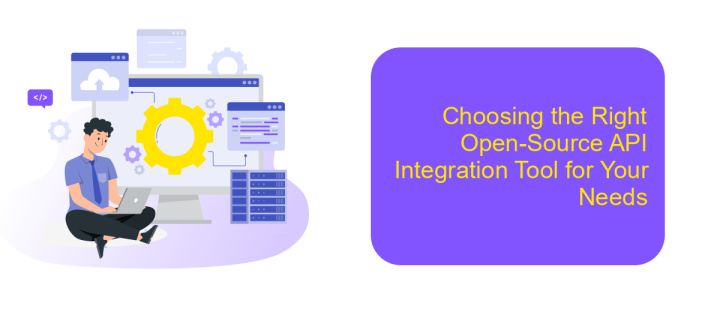Open-source API Integration Tools
In today's rapidly evolving digital landscape, open-source API integration tools have become essential for developers seeking flexibility and efficiency. These tools enable seamless communication between disparate systems, fostering innovation and collaboration. By leveraging open-source solutions, organizations can customize integrations to meet specific needs while benefiting from community-driven improvements. This article explores the advantages and popular options available, empowering developers to make informed decisions in their integration projects.
Introduction to Open-Source API Integration Tools
Open-source API integration tools have revolutionized the way developers connect and interact with various software applications. These tools provide a cost-effective and flexible solution for businesses looking to streamline their processes and enhance their digital ecosystems. By leveraging open-source solutions, organizations can customize and adapt integrations to meet their specific needs without being locked into proprietary systems.
- Cost Efficiency: Open-source tools eliminate licensing fees, reducing overall expenses.
- Flexibility: Developers can modify and extend the code to suit unique requirements.
- Community Support: A vast community of developers contributes to continuous improvement and troubleshooting.
- Transparency: Access to source code ensures transparency and security.
Incorporating open-source API integration tools into your development strategy can significantly enhance productivity and innovation. These tools not only facilitate seamless communication between disparate systems but also empower developers to build scalable and robust solutions. As businesses increasingly rely on digital transformation, embracing open-source technologies becomes crucial for staying competitive and responsive to market demands.
Key Features and Benefits of Open-Source API Integration Tools

Open-source API integration tools offer a range of key features that make them indispensable for developers and businesses alike. They provide flexibility and customization, allowing users to modify and extend functionalities to meet specific needs. These tools often come with robust community support, where developers can share insights and solutions, fostering innovation and rapid problem-solving. Additionally, open-source platforms typically ensure transparency and security, as the code is publicly accessible for auditing and improvements. This transparency builds trust among users, knowing that the software is continuously scrutinized and enhanced by a global community.
The benefits of using open-source API integration tools are significant. They often reduce costs associated with licensing fees, making them an economical choice for startups and enterprises. Tools like ApiX-Drive simplify the integration process, enabling seamless connectivity between various applications and services without extensive coding. This ease of use accelerates development time, allowing businesses to focus on core activities rather than integration challenges. Moreover, open-source tools are highly scalable, adapting to growing business demands without requiring costly upgrades. These advantages make open-source API integration tools a strategic asset in the digital transformation journey.
Popular Open-Source API Integration Tools and Their Use Cases

Open-source API integration tools play a crucial role in modern software development, offering flexibility and cost-effectiveness. These tools enable seamless communication between different software applications, enhancing functionality and user experience. They are particularly valuable for developers looking to streamline processes without incurring high costs associated with proprietary solutions.
- Apache Camel: Known for its versatility, Apache Camel supports a wide range of protocols and data formats, making it ideal for routing and mediation rules.
- WSO2 Enterprise Integrator: This tool provides a comprehensive solution for integrating services, data, and APIs, perfect for enterprise-level applications.
- Kong: An API gateway that excels in managing, monitoring, and securing APIs. It is widely used for its scalability and performance.
- Huginn: Best suited for building agents that automate web tasks, Huginn is a powerful tool for personal and small business use cases.
These tools demonstrate the power and flexibility of open-source solutions in API integration. Whether for small projects or large-scale enterprise systems, they offer robust capabilities to meet diverse integration needs. By leveraging these tools, developers can optimize workflows and enhance application interoperability efficiently.
Choosing the Right Open-Source API Integration Tool for Your Needs

When selecting an open-source API integration tool, it's crucial to consider your specific needs and project requirements. The right tool can significantly enhance your workflow, streamline processes, and reduce development time. Begin by assessing the complexity of your integration needs and the technical expertise of your team.
Next, evaluate the features offered by various tools. Some tools provide extensive support for different protocols and data formats, while others excel in ease of use and community support. Consider the scalability of the tool to ensure it can grow with your project demands.
- Compatibility: Ensure the tool supports the APIs and platforms you intend to integrate.
- Documentation: Comprehensive documentation is essential for smooth implementation and troubleshooting.
- Community Support: A vibrant community can provide valuable insights and assistance.
- Security: Check for features that ensure data protection and secure connections.
Finally, test a few shortlisted tools to understand their performance and usability. A trial run can reveal potential challenges and help you make an informed decision. By carefully considering these factors, you can select an API integration tool that aligns with your project's goals and technical landscape.
- Automate the work of an online store or landing
- Empower through integration
- Don't spend money on programmers and integrators
- Save time by automating routine tasks
Best Practices and Future Trends in Open-Source API Integration
When integrating open-source APIs, adhering to best practices is crucial for ensuring efficiency and security. First, always prioritize thorough documentation to understand the API's capabilities and limitations. Utilize standardized authentication methods like OAuth 2.0 to protect data exchanges. It is also important to implement robust error handling to manage potential disruptions gracefully. Tools like ApiX-Drive can facilitate seamless integration by offering user-friendly interfaces and automation capabilities, allowing businesses to connect different applications without extensive coding knowledge.
Looking towards the future, open-source API integration will likely see increased emphasis on AI and machine learning to enhance automation and predictive capabilities. The rise of microservices architecture will drive demand for more agile and scalable API solutions. Additionally, as data privacy regulations evolve, there will be a stronger focus on compliance and secure data handling practices. Open-source communities will continue to play a pivotal role in fostering innovation, collaboration, and the development of new standards to meet these emerging challenges.
FAQ
What is an open-source API integration tool?
How do open-source API integration tools benefit developers?
What are some common features of open-source API integration tools?
How do open-source API integration tools handle security?
Can non-developers use open-source API integration tools?
Apix-Drive is a simple and efficient system connector that will help you automate routine tasks and optimize business processes. You can save time and money, direct these resources to more important purposes. Test ApiX-Drive and make sure that this tool will relieve your employees and after 5 minutes of settings your business will start working faster.


